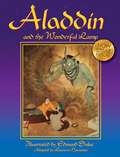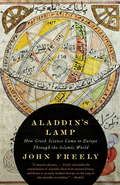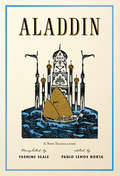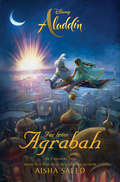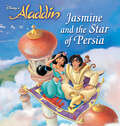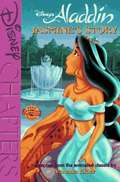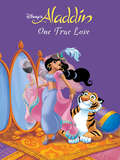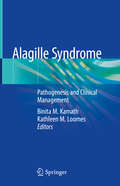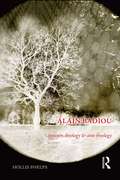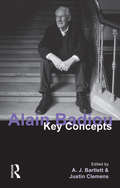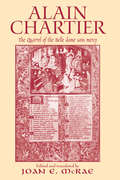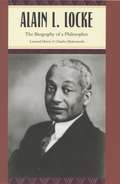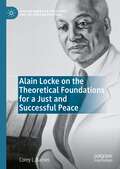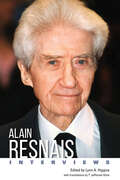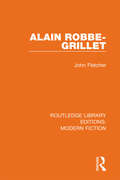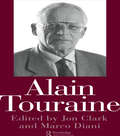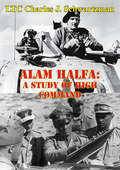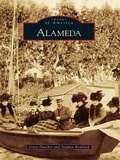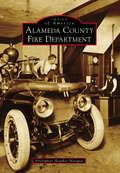- Table View
- List View
Aladdin and the Magic Lamp
by Deborah HautzigWith the aid of a genie from a magic lamp, Aladdin fights an evil magician and wins the hand of a beautiful princess.
Aladdin and the Wonderful Lamp
by Laurence HousmanA feckless boy is lured by a wicked magician into a trap but the scheme backfires — the boy, Aladdin, is left with a magical lamp and a genie who showers him with riches. Aladdin's wealth makes him an attractive suitor for the sultan's daughter, but when the evil sorcerer returns to kidnap the bride, the young hero must rescue his princess or die trying.This classic retelling of the ever-popular Middle Eastern folktale has entranced readers for over a century. Originally published in 1914 as part of Sindbad the Sailor and Other Stories from The Arabian Nights, this beautiful version by Laurence Housman features eight full-color images by Edmund Dulac, one of the era's most famous illustrators.
Aladdin's Lamp
by John FreelyAladdin’s Lamp is the fascinating story of how ancient Greek philosophy and science began in the sixth century B.C. and, during the next millennium, spread across the Greco-Roman world, producing the remarkable discoveries and theories of Thales, Pythagoras, Hippocrates, Plato, Aristotle, Euclid, Archimedes, Galen, Ptolemy, and many others. John Freely explains how, as the Dark Ages shrouded Europe, scholars in medieval Baghdad translated the works of these Greek thinkers into Arabic, spreading their ideas throughout the Islamic world from Central Asia to Spain, with many Muslim scientists, most notably Avicenna, Alhazen, and Averroës, adding their own interpretations to the philosophy and science they had inherited. Freely goes on to show how, beginning in the twelfth century, these texts by Islamic scholars were then translated from Arabic into Latin, sparking the emergence of modern science at the dawn of the Renaissance, which climaxed in the Scientific Revolution of the seventeenth century.
Aladdin: A New Translation
by Paulo Lemos HortaA dynamic French-Syrian translator, lauded for her lively poetic voice, tackles the enchanted world of Aladdin in this sparkling new translation. Long defined by popular film adaptations that have reductively portrayed Aladdin as a simplistic rags-to-riches story for children, this work of dazzling imagination—and occasionally dark themes—finally comes to vibrant new life. “In the capital of one of China’s vast and wealthy kingdoms,” begins Shahrazad— the tale’s imperiled-yet-ingenious storyteller—there lived Aladdin, a rebellious fifteen-year-old who falls prey to a double-crossing sorcerer and is ultimately saved by the ruse of a princess. One of the best-loved folktales of all time, Aladdin has been capturing the imagination of readers, illustrators, and filmmakers since an eighteenth-century French publication first added the tale to The Arabian Nights. Yet, modern English translators have elided the story’s enchanting whimsy and mesmerizing rhythms. Now, translator Yasmine Seale and literary scholar Paulo Lemos Horta offer an elegant, eminently readable rendition of Aladdin in what is destined to be a classic for decades to come.
Aladdin: Far From Agrabah
by Aisha SaeedThis stunning original novel will tell an all-new story set in the world of the new film, featuring Aladdin and Jasmine. A magic carpet ride full of adventure, suspense, and wonder written by New York Times Bestselling author Aisha Saeed, this story will be a must-read for any Aladdin fans who find themselves drawn into and enchanted by the magical world of Agrabah and beyond.
Aladdin: Jasmine and the Star of Persia
by DISNEY BOOK GROUPOne night, as Princess Jasmine and her husband Aladdin gaze at the night sky, Aladdin points to a star and tells Jasmine the story of the Star of Persia: the biggest, most beautiful jewel in the world. Legend has it that the jewel belonged to a beautiful queen, and after she died, her subjects hid the jewel in a tower, certain that no one could be worthy of its beauty again. Now Jasmine is determined to know if the story is true. So the next morning, Jasmine, Aladdin, Abu, and the Magic Carpet set off to find out! Will the friends be able to find the legendary jewel, or are all the stories just fiction?
Aladdin: Jasmine's Story
by Vanessa ElderThis book is a great adaptions from Disney's Aladdin. Princess Jasmine tells the story of Disney's Aladdin in her own way.
Aladdin: One True Love
by Annie AuerbachAladdin and Jasmine are happily married, and the Genie has returned from a trip around the world! But the Genie has been feeling blue. All his traveling has made him lonely, and he wishes he could find another genie to share his life with. So when Aladdin runs off to catch a kangaroo the Genie brought back from Australia, Jasmine recounts the story of how she found her one true love: Aladdin! Will Jasmine be able to cheer up the Genie and help him find his one true love?
Alafair Burke/Ellie Hatcher Collection
by Alafair BurkeFrom bestselling thriller author Alafair Burke come books 2-4 in her popular Ellie Hatcher series: 212, Angel's Tip, and Never Tell.
Alagille Syndrome: Pathogenesis And Clinical Management
by Binita M. Kamath Kathleen M. LoomesThis text provides a concise yet comprehensive overview of Alagille syndrome. The book reviews the pathophysiology and genetics of the disorder, discusses recent molecular advances and its impact on diagnostics, and describes management challenges and strategies. The text also touches upon future treatment options.Written by experts in the field, Alagille Syndrome: Pathogenesis and Clinical Management is a valuable resource for physicians and researchers dealing with this disorder, one that will help guide patient management and stimulate investigative efforts.
Alain Badiou: Between Theology and Anti-Theology
by Hollis Phelps'Alain Badiou: Between Theology and Anti-theology' provides one of the first comprehensive analyses of the relationship between Badiou's philosophy and theology. Examining the full range of Badiou's writings, this provocative study explores how Badiou's philosophy relies on theology even if he claims otherwise and actively attempts to work against theology. Despite the complex questions discussed - ranging across ontology, the theory of truth and the subject, philosophy and its conditions, and anti-philosophy - this book presents a clear and accessible overview of the theological, religious and biblical themes which animate Badiou's philosophy.
Alain Badiou: Key Concepts (Key Concepts)
by Justin Clemens A. J. BartlettAlain Badiou is one of the world's most influential living philosophers. Few contemporary thinkers display his breadth of argument and reference, or his ability to intervene in debates critical to both analytic and continental philosophy. Alain Badiou: Key Concepts presents an overview of and introduction to the full range of Badiou's thinking. Essays focus on the foundations of Badiou's thought, his "key concepts" - truth, being, ontology, the subject, and conditions - and on his engagement with a range of thinkers central to his philosophy, including Plato, Descartes, Spinoza, Heidegger and Deleuze.
Alain Chartier: The Quarrel of the Belle Dame Sans Mercy (Routledge Medieval Texts #5)
by Joan E. McRaeBelle dame sans merci (Beautiful lady with no mercy) (1424) is not readily available in moden English translation elsewhere, making this an essential addition to any library with a medieval literature or French literature collection.
Alain L. Locke: Biography of a Philosopher
by Leonard Harris Charles MolesworthAlain L. Locke (1886-1954), in his famous 1925 anthology "The New Negro", declared that "the pulse of the Negro world has begun to beat in Harlem". Often called the father of the Harlem Renaissance, Locke had his finger directly on that pulse, promoting, influencing, and sparring. Leonard Harris and Charles Molesworth trace Locke's story through his Philadelphia upbringing, his undergraduate years at Harvard and his tenure as the first African American Rhodes Scholar. The heart of their narrative illuminates Locke's heady years in 1920s New York City and his forty-year career at Howard University, where he helped spearhead the adult education movement of the 1930s and wrote on topics ranging from the philosophy of value to the theory of democracy. Harris and Molesworth show that throughout this illustrious career -- despite a formal manner that many observers interpreted as elitist or distant -- Locke remained a warm and effective teacher and mentor, as well as a fierce champion of literature and art as means of breaking down barriers between communities. The multifaceted portrait that emerges from this engaging account effectively reclaims Locke's rightful place in the pantheon of America's most important minds.
Alain Locke on the Theoretical Foundations for a Just and Successful Peace (African American Philosophy and the African Diaspora)
by Corey L. BarnesAlain Locke is most known for his involvement in the Harlem Renaissance. However, he received his PhD in philosophy from Harvard University in 1918, and produced a very large corpus of philosophical work. His work shows him to have been a sophisticated philosopher who thought through practical and theoretical problems regarding the nature of cosmopolitanism, democracy, race, value, religion, art, and education. Although Locke’s philosophical work has been discussed in parts, there has been no theorizing about how his different philosophical commitments fit together. In this book Corey L. Barnes begins to systematize Locke’s philosophical thought, showing how his democratic theory, philosophy of race, and value theory are connected to and undergirded by a commitment to cosmopolitanism. In so doing, Barnes unearths aspects of Locke’s thought—for example, his economic thinking—that have not been accorded attention and reimagines parts of his work about which have been theorized, all while bringing Locke into current debates about each subject.
Alain Resnais: Interviews (Conversations with Filmmakers Series)
by T. Jefferson KlineAmong the most innovative and influential filmmakers of the twentieth century, Alain Resnais (1922–2014) did not originally set out to become a director. He trained as an actor and film editor and, during the sixty-eight years of his working life, delved into virtually every corner of filmmaking, working at one time or another as screenwriter, assistant director, camera operator and cinematographer, special effects coordinator, technical consultant, and even author of source material. From such award-winning documentaries as Van Gogh and Night and Fog to the groundbreaking dramas Hiroshima mon amour, Last Year at Marienbad, and Muriel, Resnais’s films experiment with such themes as consciousness, memory, and the imagination. Distinguishing himself from associations with the French New Wave movement, Resnais considered his films to be “anti-illusionist,” never allowing his spectators to forget they were watching a work of art. In Alain Resnais: Interviews, editor Lynn A. Higgins collects twenty-one interviews with the filmmaker, twelve of which are translated into English for the first time. Spanning his entire career from his early short subjects to his final feature film, the volume highlights Resnais’s creative strategies and principles, illuminates his place in world cinema history, and situates his work relative to the New Wave, American film, and experimental filmmaking more broadly. Like his films, the interviews collected here reveal a creator who is at once an intellectual, a philosopher, an entertainer, a craftsman, and an artist.
Alain Robbe-Grillet (Routledge Library Editions: Modern Fiction #16)
by John FletcherAlain Robbe-Grillet had traditionally been seen as an austere experimentalist in fiction, addicted to arid and interminable descriptions of objects like coffee pots, erasers and pieces of string. His own rather bellicose theoretical pronouncements were partly to blame for this unattractive picture, belied by the immense popular success of the film Last Year at Marienbad (1961) (made by Alain Resnais from Robbe-Grillet’s script) and the high critical esteem in which novels like Jealousy and The Voyeur are held. In his original study, first published in 1983, John Fletcher attempts to resolve this paradox by offering a new interpretation of Robbe-Grillet’s work which stresses the subversive qualities of his imagination and the disturbing power of his vision of a world of labyrinths and bizarre sexual stereotypes, haunted by images of love and loss.
Alain Touraine (Falmer Sociology Ser. #Vol. 2)
by Jon Clark Marco DianiFirst published in 2004. The seventeen essays in this volume discuss the work of Alain Touraine and consider his contribution to the social sciences. The text includes his most recent thinkings on the market and communities.
Alam Halfa: A Study Of High Command
by LTC Charles J. SchwartzmanIn recent years the army has adopted rigorous programs which evaluate the competence and leadership abilities of its combat leaders. For the first time, senior leaders are being formally evaluated as they command their units in the simulated combat environment provided by the Battle Combat Training Program (BCTP). Preparation for BCTP will require introspection and thought as the commander develops his concept of the operation and establishes the vision to guide his organization. This paper can assist the commander in this effort by challenging his thought processes and by provoking him to find answers to the problems of command. It describes the Battle of Alam Halfa which was fought in North Africa in 1942. It is appropriate because its major participant, General Bernard Montgomery, had a uniquely "BCTP-type" mission. He was expected to assume command, imprint his methods and procedures on his army, and fight a major battle within a two-week period. The study includes an overview of the following: the situation in North Africa during the summer of 1942; the steps Montgomery took to prepare his force for battle; and the fighting itself. It concludes with an analysis of the battle using the AirLand Battle imperatives.
Alameda
by Stephen Rowland Greta DutcherAlameda was once a peninsula of grassy fields and sandy beaches, separated from Oakland by a snaking estuary. A tidal canal made Alameda an island in 1902 and its waterfront became a major shipping port. Park Street's bay-windowed commercial buildings looked out on a prosperous city of streetcars and comfortable homes. Between the two world wars, Alameda's Neptune Beach resort and amusement park became the "Coney Island of the West," eventually boasting a Moorish entrance tower on Webster Street, a stadium, two swimming pools, a high dive, and a roller coaster called the "Whoopie." Alameda's strategic location made its "airdrome" the busiest in the world in the 1930s and eventually attracted a U.S. Coast Guard base, known as Government Island, and the Alameda Naval Air Station.
Alameda (Postcard History Series)
by Stephen Rowland Greta DutcherAlameda was once a peninsula of grassy fields and sandy beaches, separated from Oakland by a snaking estuary. A tidal canal made Alameda an island in 1902 and its waterfront became a major shipping port. Park Street�s bay-windowed commercial buildings looked out on a prosperous city of streetcars and comfortable homes. Between the two world wars, Alameda�s Neptune Beach resort and amusement park became the �Coney Island of the West,� eventually boasting a Moorish entrance tower on Webster Street, a stadium, two swimming pools, a high dive, and a roller coaster called the �Whoopie.� Alameda�s strategic location made its �airdrome� the busiest in the world in the 1930s and eventually attracted a U.S. Coast Guard base, known as Government Island, and the Alameda Naval Air Station.
Alameda County Fire Department (Images of America)
by Firefighter Heather MarquesAlameda County spans from the shores of the San Francisco Bay to the golden inland hills. Alameda County Fire Department (ACFD) is comprised of multiple consolidated agencies that began joining forces and sharing resources in 1993. Protecting unincorporated county land as well as Ashland, Cherryland, San Lorenzo, Castro Valley, San Leandro, Dublin, Union City, Newark, Emeryville, and the National Laboratories at Livermore and Berkeley, ACFD serves over 500 square miles and 330,000 citizens. This legacy stretches back 140 years, recalling the shared experiences of bucket brigades, teams of horses pulling steam-engine pumpers down muddy roads, the advent of motorized apparatus, and the days when school boys would be pulled from class to ride tailboard to fight blazes in the hills. These agencies have sent soldiers to two world wars, survived massive earthquakes, fought catastrophic wildfires, and touched the lives of Bay Area citizens for over a century. The ACFD is the sum of its many unique parts, which together form a premier, all-risk fire department.


